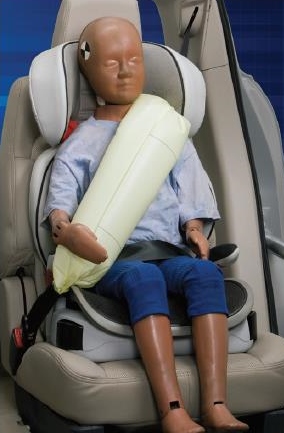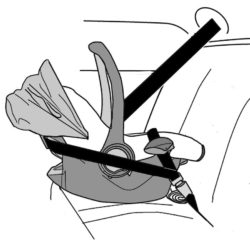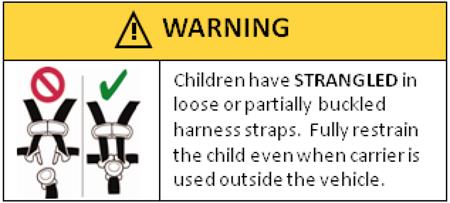Certain aspects of vehicle manuals differentiate them from CR manuals. For instance, vehicle manuals must cover topics ranging far beyond CPS, and CPS-related topics appear in multiple sections of a vehicle manual. Therefore, when reading vehicle manuals—or instructing others to read them—it helps to understand the following: Read More from “Tips for Reading Vehicle Manuals”
Topic: Using Car Seats, Booster Seats, and Seat Belts
Using car seats, boosters, and set belts for children of all ages.
Avoid the Unintended Consequences of CR Cleanliness
In 2014, the University of Birmingham (United Kingdom) studied how germ types and levels in cars compared to those in people’s homes. While they found plenty of germs in people’s vehicles, it was in car seats that the results really stood out. Researchers found that, on average, every square centimeter of a car seat contained at least 100 bacteria and fungi—twice as many as on a toilet seat.
Naturally, this report was widely circulated in the media that year, and people were understandably grossed out. It is certainly a reminder for CPSTs to stock their tool kit with hand sanitizer and use it routinely while working in cars.
Read More from “Avoid the Unintended Consequences of CR Cleanliness”
NHTSA Policy Reaffirmation of September 2017
The following statement is from NHTSA.
 As you know, there have been communications and on-going technical reviews regarding the validity of the 2007 study comparing the injury risk between rear- and forward-facing car seats for children less than 2 years of age in the United States (Henary et al, 2007). Some of these communications may have caused uncertainty regarding child passenger safety and educational messages given to caregivers.
As you know, there have been communications and on-going technical reviews regarding the validity of the 2007 study comparing the injury risk between rear- and forward-facing car seats for children less than 2 years of age in the United States (Henary et al, 2007). Some of these communications may have caused uncertainty regarding child passenger safety and educational messages given to caregivers.
It is important to note that all the studies in question demonstrate the value and effectiveness that car seats play in keeping children safe while traveling.
Read More from “NHTSA Policy Reaffirmation of September 2017”
Steps for Addressing the Use of Inflatable Seat Belts (ISBs) With CRs
ISBs have been an available option in the outboard seating position of some Ford and Lincoln vehicles for the past five years. Over that time, the number of Ford/Lincoln models with this option has grown (see current list, at bottom of page) and now includes both two- and three-row vehicles.
Read More from “Steps for Addressing the Use of Inflatable Seat Belts (ISBs) With CRs”
Nissan/Infiniti Issues Two Recalls Affecting Children
Nissan/Infiniti is recalling 3,177,645 cars in the U.S. due to continuing problems with the vehicles’ Occupant Protection Classification (OPC) software, which determines whether the front passenger air bag should deploy based on whether an occupant is present and that occupant’s size.
Read More from “Nissan/Infiniti Issues Two Recalls Affecting Children”
It’s 2016! Are You Still Using Locking Clips?
Editor’s Intro:
Although it may seem odd now, many in the CPS community were wary of switchable retractors when they first became available in the late 1990s. After relying on locking clips (pictured left) for so many years, some installations just seemed tighter using them.
I remember being scolded by our certification course instructor during hands-on practice for using a locking clip in a situation that could have been handled using the vehicle’s switchable belt. I explained that I’d tried to use the switchable belt, but the installation was even tighter using the tried-and-true locking-clip approach. But the instructor was unimpressed with my argument and taught me an important lesson: When picking between an installation approach that improves tightness only marginally and an approach that is vastly easier for the caregiver to replicate, one should choose the latter because it empowers the caregiver.
Read More from “It’s 2016! Are You Still Using Locking Clips?”
Study Finds CR/Vehicle Mismatch Prevalent
In October, a study was published that predicted that 42 percent of the time, vehicles and CRs are somehow incompatible. The study, “Investigation of Child Restraint System Compatibility in the Vehicle Seat Environment,” by Ohio State College of Medicine’s Injury Biomechanics Research Center, used measurements of 59 current CRs and 61 late model vehicles to evaluate over 3,599 possible CR/vehicle combinations and predict likely incompatibilities. To validate the results, researchers conducted physical installations of 34 of the scenarios.
First Ride—Not Always a Safe Ride
A new study of 267 newborn infants who were discharged from Oregon Health and Science University Hospital between November 2013 and May 2014 shows that almost all (93 percent) of the parents made significant errors in CR use or installation.
What CPSTs, Caregivers Should Know About European Belt Routing
European belt routing for rear-facing CRs is not new here in the U.S. For many years there have been at least a few RF-only models with this installation option. However, with growing global influence in the CR marketplace, models with this option have been on the rise in recent years. This article takes a closer look at this installation method.
Read More from “What CPSTs, Caregivers Should Know About European Belt Routing”
New Requirements for RF-Only CRs, Other Hand-Held Carriers
Did you know that NHTSA is not the only government agency that oversees CRs? That’s because RF-only CRs with handles are also considered carriers. To enhance the safety of carriers, a new Consumer Products Safety Commission (CPSC) standard goes into effect on June 6, 2014. It applies to RF-only CRs as well as any other rigid- or semi-rigid-sided, hand-held carrier (i.e.: portable cradles and Moses baskets). Watch for this new label to appear soon on the padding around the head area of all RF CRs. It can be used to introduce caregivers to the topic of appropriate use of CRs, both in and out of the vehicle.
Read More from “New Requirements for RF-Only CRs, Other Hand-Held Carriers”






